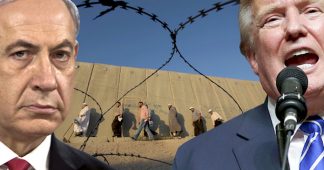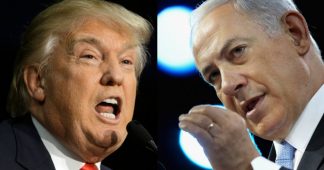By Yasin Aktay
The U.S.’s political mind, humanitarian values and rationality are not proportionate to its power. Unfortunately, the area of influence it occupies in the world through brute force also offers no hope or positive expectation for humanity. Every step it takes, due to its brute force, stirs up world politics. But recently, this effect has always been destructive, not constructive.
The Donald Trump administration even voicing the topic of moving the U.S.’s Israel embassy to to Jerusalem initially fueled all world politics, primarily the Muslim world. Great anger is directed at the U.S. administration from the Muslim world.
President Recep Tayyip Erdoğan has also said that he will not sit and watch a decision the U.S. administration will take in this direction and that he does not have the slightest hesitation in relation to taking all the necessary measures.
Turkey is also the term president for the Organization of Islamic Cooperation (OIC). In the event that such a step is taken, Erdoğan has warned that he would gather the OIC leaders summit in Istanbul within 15 days, that the process could lead to the point of severing diplomatic ties with Israel and sharply warned the U.S. against taking such a step.
The president’s statement, “Jerusalem is our red line,” reflecting the feelings of the entire Muslim world, is important in that it reflects the determination of both Turkey and the Muslim world. This statement echoed like the sound of hope in the media of the Muslim world.
Of course, whether the U.S. will move its embassy to Jerusalem after this point is a matter of curiosity, however, it should not be overlooked that there is a context to this topic. This matter, as a matter of fact, has a history going far back, long before the Trump administration.
The agenda concerning moving the U.S.’s embassy to Jerusalem is, probably, one of Zionism’s strategic goals and plans since the day Israel was established.
This is one of the files that remain open at all times in the hands of the Jewish lobbies in the U.S. Hence, the first steps taken in this regard had also come into question in the 1990s, during President Bill Clinton’s term. The Jerusalem Embassy Act of 1995, which passed the Senate on Oct. 23, 1995 and the House of Representatives on Oct. 24, 1995, prescribed moving the embassy to Jerusalem, however, the political conjuncture of the time did not allow the enforcement of this decision. In addition to this, no new regulation that would abolish this decision came into question either.
The said decision states that Jerusalem has been the capital of Israel since 1950, yet it was divided until 1967, and after the 1967 war known as the Six-Day War, Jerusalem became united and, in 1996, Israel saying that the Jews will be celebrating the 3,000th year of their presence in Jerusalem after King David entered Jerusalem, foresaw the U.S. Embassy in Israel to be moved to Jerusalem by no later than May 31, 1999.
George W. Bush, who came to office after Clinton, also, during his election campaign, had promised to implement this regulation, in other words, to move the U.S. Embassy to Jerusalem. However, when Bush also, similar to Clinton, started the Palestine-Israel peace process to mark the U.S.’s hegemony over the world and its own role over the system, he did not implement the decision throughout his presidency saying it might negatively affect the process. Similarly, during Barak Obama’s presidency, although this 1995 regulation came up on the agenda time and again, it could not be implemented.
So, there was a context to Trump bringing up this topic during his presidential campaign. Of course, Trump announcing that the U.S. would withdraw from the nuclear agreement with Iran, cutting the payment to the U.N. Human Rights Council, which constantly takes decisions against the U.S. (and Israel) and the promise to withdraw from UNESCO instigated Benjamin Netanyahu’s administration in Israel to support Trump, but the greatest motivation was provided by the promise to move the U.S embassy to Jerusalem as soon as Trump became president. Such that as soon as the election results were announced, Netanyahu made a statement first congratulating Trump, then said that they expect the certain promises he made during the election campaign concerning Israel to be implemented as soon as possible.
At the current point, it is possible to say that Netanyahu’s expectations were largely met. We will see whether the Jerusalem decision will be enforced. However, although we do not have very clear information, we can note for now that one of the topics of dispute between the Pentagon and the Trump administration is this matter.
In short, the plan to move the U.S. Embassy to Jerusalem is neither a new development, not is it going to be an end in the Trump administration’s Palestine policy. It is not difficult to say that our next topic of discussion will be, “a single state solution process.” The crisis in the region is becoming constant, it is becoming institutionalized. The strategy called “creative chaos” by Bush’s National Security Adviser Condoleezza Rice and the social scientists around him, is going to start being implemented in the region.
However, it should first be noted that this creative chaos is slowly turning into a fire that directly surrounds the U.S. as well, and that the U.S. is burning down its throne in world politics.
Second, it might even be unnecessary to state at this stage, but there has not even been the slightest progress in terms of solution in the Palestine issue carried out by the U.S. Third, how the new axis politicians seeking a new political future for themselves in normalizing relations with Israel in the Muslim world will find what they are looking for, or what kind of future will the thing they find prepare for them will be an important topic on the agenda.











